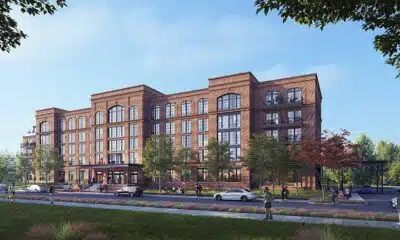News from the South - Louisiana News Feed
Louisiana immigration judge defers to ICE center operator on court rules
by Delaney Nolan, Louisiana Illuminator
May 21, 2025
The federal judge overseeing the case of a Columbia University student activist held at a Louisiana immigration detention center has deferred to the private prison company managing the facility in determining certain rules for her court.
The questioned standards come into play as Mahmoud Khalil faces his next court hearing Thursday morning at the LaSalle Detention Center in Jena, when his attorneys say they’ll file a motion to throw out the case against him for “egregious government misconduct,” namely that Khalil was arrested without a warrant. They’ll also argue that Khalil is at risk of harm by Israel “anywhere in the world” and thus cannot be removed to Syria or Algeria.
The hearing is the first since one of Khalil’s attorneys, Nora Ahmed with the American Civil Liberties Union, was prevented from bringing her laptop computer into the courtroom on the grounds of the LaSalle Detention Center for an April 11 hearing. Assistant Chief Immigration Judge Jamee Comans said Khalil’s attorneys must abide by policies set by the facility’s operator, the GEO Group. Ahmed was prevented from having her electronics with her, despite attorneys for the federal government being allowed to have their computers.
GET THE MORNING HEADLINES.
Comans’ ruling gives the Trump administration an unfair advantage in the case, Ahmed said in an interview with the Illuminator.
“It facially goes to show how biased the hearing was from the get-go – that this attorney was denied all of the access to electronics that the government” had, Ahmed said.
Khalil has been held at the Lasalle Detention Center since March 8, when federal authorities took him from his Columbia University apartment building in New York City. Although he’s a legal U.S. resident, ICE officials said they had a warrant to revoke Khalil’s student visa. He’s the first person President Donald Trump sought to deport from the U.S. for his involvement in pro-Palestinian campus protests.
Motion sought formal order
Over two months after being taken into federal custody, Khalil has yet to be charged with a crime. At his April 11 hearing, Comans ruled him deportable in light of a letter from Secretary of State Marco Rubio stating that Khalil’s activities at Columbia could have “adverse foreign policy consequences.”
According to a motion filed April 28, Ahmed was prevented from bringing her laptop and phone into that hearing, despite DOJ policy explicitly allowing counsel to have electronics. Ahmed said she had already been given permission to take her electronics inside by the ICE facility’s warden, GEO Group employee Shad Rice. GEO Group personnel handle security for the facility, including the secured area between the facility’s entrance and the courtroom doors.
Unable to bring her computer into the courtroom, Ahmed worked with a notebook and pen instead.
Judge Comans’ refusal to let Ahmed retrieve her computer is in direct violation of the Department of Justice’s policy, according to the April 29 motion. The policy states that attorneys “in proceedings before [Executive Office for Immigration Review] will be permitted to use electronic devices in EOIR courtrooms.”
After the hearing, according to the motion, Rice told Ahmed that “the Judge appeared to contradict herself” by blaming him and the GEO Group for Ahmed not being allowed to bring her laptop into the courtroom.
Jason Burke, administrator for the LaSalle Immigration Court, told the Illuminator that Justice Department rules do indeed allow Ahmed to bring her laptop to court proceedings, “but they got to get to EOIR space first. which we don’t control when we’re in a detention center.”
The GEO Group declined to answer questions regarding the matter.
In light of the confusion on April 11, the April 28 motion asked the court to ensure that Khalil’s counsel at upcoming hearings could bring their electronics into chambers.
Comans ruled May 9 that the motion was moot, writing that “should an attorney elect to appear in person, they are subject to the detention facility’s rules.”
Homero López, director of Immigration Services and Legal Advocacy in New Orleans, was startled when he learned of the judge’s order, which he described as “bulls–t.” López previously had a similar issue in 2022 at the South Louisiana ICE Processing Center in the Acadia Parish town of Basile. It was resolved when ICE Field Office Director Melissa Harper “clarified with Basile management that laptops will be permitted,” per emails López provided to Illuminator.
López said it was particularly surprising to have that issue at the Jena center, where, unlike other Louisiana ICE centers, the detention area and courtroom have separate entrances.
“I’ve never had to once ask anybody for additional permission to bring electronics into court” at Jena, nor has any other attorney he knows, López said. Comans should have directed ICE to get GEO Group to abide by federal policy – not defer to the company – he added.
The judge’s failure to do so “is another way to discourage people from taking on cases at that facility,” López said.
Unequal footing for ICE detainees
Khalil’s lawyers argue that the unequal access highlights a lack of transparency around immigration proceedings, and the hurdles the GEO Group and the federal justice present that affect a detainee’s legal proceedings. In a briefing for reporters Wednesday, co-counsel Ramzi Kassem, a law professor at City University of New York, described Comans as “an immigration judge who’s not an independent judge, who’s really a DOJ functionary.”
Khalil’s counsel decried this lack of transparency in a second motion, also filed April 28. The motion requested that, due to enormous public interest in Khalil’s case, Comans allow virtual or telephonic access for her proceedings.
During the April 11 hearing, Ahmed had asked permission to read out a statement about public access – a request Comans refused.
Ahmed’s quashed statement was a plea for Comans to ensure broader access to the hearing, noting that “what transpires today – determining who is allowed to stay on American soil and who must leave it – will have reverberations for years to come. As such, we ask this court to accommodate those intent on observing these proceedings.”
Instead, GEO Group security allowed less than two dozen people to enter the facility, leaving supporters and members of the news media to wait outside, some of whom had traveled from as far as New York.
Zach Kopkin, a member of Jewish Voice for Peace in New Orleans, was among those denied access. He told Illuminator that it “felt really important that Jewish folks be in that room” and “that we fight back with the truth, which is that a ton of Jews are also critical of the Israeli government’s war crimes and genocide.”
Comans also called the second motion moot, noting simply that “immigration hearings are generally open to the public, although certain exceptions apply.” Khalil’s team still has an outstanding request to the judge for an overflow room.
Khalil hopes to hold month-old son
New allegations against the GEO Group of violating federal policy in Khalil’s case were levied Wednesday. The LaSalle facility has refused to allow Khalil to hold his newborn son, who was born while he’s been in federal custody, citing “security concerns.” This comes despite ICE directives and federal policies which explicitly encourage contact between detained parents and children.
Khalil filed a request Wednesday with a federal court to order ICE to allow him a contact visit with his month-old son by the end of the day. The federal court accepted the argument and Khalil’s counsel say they’re working out details of the visit. Khalil’s wife, Dr. Noor Abdalla, traveled over 1,000 miles with their child so Khalil could hold him for the first time.
According to emails within the filing, the GEO Group’s facility administrator said its procedures allow for “non-contact” visits only through a secure window.
ICE policy notes that contact visits “may be facilitated at all ICE detention facilities.”
Khalil’s lawyers argue the GEO Group’s refusal of contact is part of the “punitive” nature of his detention and transfer from its New Jersey facility, where family contact visits are provided daily and parents are allowed to hold their children.
Judge Comans will also decide whether Dr. Abdalla is permitted to hold their infant while attending proceedings Thursday.
YOU MAKE OUR WORK POSSIBLE.
Louisiana Illuminator is part of States Newsroom, a nonprofit news network supported by grants and a coalition of donors as a 501c(3) public charity. Louisiana Illuminator maintains editorial independence. Contact Editor Greg LaRose for questions: info@lailluminator.com.
The post Louisiana immigration judge defers to ICE center operator on court rules appeared first on lailluminator.com
Note: The following A.I. based commentary is not part of the original article, reproduced above, but is offered in the hopes that it will promote greater media literacy and critical thinking, by making any potential bias more visible to the reader –Staff Editor.
Political Bias Rating: Center-Left
This content exhibits a Center-Left bias as it focuses on issues related to immigrant rights, government accountability, and opposition to the Trump administration’s immigration policies. It highlights concerns about fairness, transparency, and alleged misconduct involving federal authorities and private prison companies, emphasizing civil liberties and legal advocacy. The framing tends to be critical of the government and immigration enforcement, reflecting values commonly associated with progressive or liberal viewpoints while maintaining a fact-based, measured tone.
News from the South - Louisiana News Feed
Arrest made in Lafayette school construction investigation
SUMMARY: Robert Gautreaux, former Lafayette Parish School System construction director, was arrested on felony charges of filing false public records and injuring public records related to alleged forgery of contractor quotes for school projects. Gautreaux reportedly altered vendor documents to meet bid requirements for projects valued between $50,000 and $249,999 and attempted to cover up his actions. Despite awareness of the investigation, Superintendent Francis Touchet reassigned Gautreaux to a teaching role. Investigations revealed forged quotes involving multiple contractors, including a company hired without a license. Gautreaux faces up to five years in prison per count and fines; the probe remains ongoing.
Read the full article
The post Arrest made in Lafayette school construction investigation appeared first on thecurrentla.com
News from the South - Louisiana News Feed
Since Katrina, infrastructure shortcomings create resiliency fatigue
by Elise Plunk, Louisiana Illuminator
August 26, 2025
An American flag has been strategically placed on one of the massive beams supporting the Lake Borgne Surge Barrier, part of the New Orleans region hurricane and storm damage risk reduction system.
Completed in 2009 to close off the Mississippi River Gulf Outlet, the barrier is designed to decrease damage to the metropolitan area when a major hurricane pushes water from the Gulf of Mexico into the lakes that surround the city and neighboring parishes.
The flag on the wall symbolizes pride and mourning, a reminder of the people it protects and a memorial for those who died 20 years ago when Hurricane Katrina hit. The failure of the federal levee system Aug. 29, 2005, claimed more than a thousand lives, displaced nearly a million people in the region and left permanent scars on New Orleans.
A go-to term emerged to praise New Orleanians and their neighbors who persevered through the catastrophe and took part in the unprecedented rebuilding: resilient. But as various recovery programs faltered and efforts to ensure disaster history would not repeat itself stalled, “resilient” or “resiliency” now elicit bitter feelings among locals.
“I think people have gotten tired of the word. Not just because it’s become cliché, but because people have begun to understand it as an excuse for lack of preparation or execution, lack of planning or execution,” said Michael Hecht, CEO and president of Greater New Orleans Inc., a regional economic development group.
Hecht came to Louisiana in 2006 from New York, where he led a 9/11 small business recovery program for New York Mayor Michael Bloomberg. After directing the state’s post-Katrina business recovery efforts, he was chosen to lead GNO Inc. in 2008.
“We had been knocked down by an unprecedented event,” Hecht said. “It was either be resilient or die, so we were resilient.”
The world has watched as New Orleans fundamentally changed, having lost a significant portion of its Black working class and attracting an upsurge in mostly white transplants from out of state. With more than 484,000 residents before Katrina, the city’s population plummeted below 344,000 in the 2010 census. The number climbed above 391,000 in 2020 and has since fallen about 4% as of 2024, according to various estimates.
Most who have stayed are ardent defenders of the city’s culture, of which resiliency fatigue is quickly becoming a feature. It’s reflected in Louisiana’s slow progress to rebuild coastal land and improve the adaptability of cities to match what post-Katrina boosters envisioned.
GET THE MORNING HEADLINES.
Restoration resistance
After Katrina, more emphasis was placed on rebuilding Louisiana’s vanishing coastal wetlands to protect residents from the increasing threat of hurricanes. A state Coastal Master Plan has taken shape over the past two decades, gaining official approval in 2023, to tie together restoration efforts and shield wetlands from sea level rise, subsidence and worsening hurricanes.
“We learned from Hurricane Katrina that levees alone aren’t enough,” said Alisha Renfro, a coastal scientist with National Wildlife Foundation. “We also need a healthy natural ecosystem sitting out in front of those levees to protect the structures that protect our communities.”
But the master plan encountered a huge setback in July with the end of what had been its keystone project, the Mid-Barataria Sediment Diversion project. Gov. Jeff Landry led pushback against the project for its feared impact on fisheries and nearly $3 billion price tag.
So far, the state’s Coastal Restoration and Protection Authority has spent $600 million to harness the power of the Mississippi River to bring fresh water and sediment to wetlands in the Barataria Basin – only to shelve the diversion.
“It was probably one of the most innovative, forward-thinking things in terms of being a resilience hub for the world,” said Amanda Moore, senior director for the National Wildlife Federation’s Gulf program.
A lifetime Gulf Coast resident, Moore moved to New Orleans from the Tampa, Florida, area in 2009 to take a job as a community organizer with the National Wildlife Federation. She joined the wave of thinkers, scientists and planners who came to the city after Katrina with the hope of bringing relief from the constant threat of flood.
“For people who live on the Gulf Coast – and especially South Louisiana – it’s exhausting,” she said.
The federation was among the voices that influenced upgrades to the region’s storm risk reduction system in the years after Katrina. Moore led efforts such as the MRGO Must Go Coalition, advocating for reversal of wetlands damage attributed to saltwater intrusion from the Mississippi River Gulf Outlet.
“You’re helping to alleviate maybe some of that exhaustion that people are personally feeling when you do the coastal restoration,” Moore said. “You’re adding this layer of protection, you’re helping it create a healthier environment that’s safer, so that does help people really be more resilient and not burnt out.”
Funding momentum peters out
As Katrina and its aftermath garnered worldwide attention, the recovery money streamed in from Washington and charitable foundations. The federal government directed $76 billion to Louisiana projects.
But keeping up the pace of investment after post-disaster attention spans waned became a problem for state and local leaders. Even with billions of dollars put into infrastructure, billions more would be needed for upkeep and replacing outdated systems. Stormwater drainage and drinking water in New Orleans, for example, rely on a power supply and mains that, in many spots, are more than a century old.
Charles Allen, Gulf Coast community engagement director for the National Audubon Society, recalls the vast amounts of federal and philanthropic dollars directed to the region in the years immediately after Katrina – and the dropoff that followed. It revealed the inability of state and local governments to sustain the level of rebuilding needed.
“It’s like anything in life, you know?” Allen said. “We gotta maintain our bodies, and we have to invest in whatever it takes to do that.”
The 2010 explosion of the Deepwater Horizon just off the Southeast Louisiana coast reopened wounds in the region that had yet to heal from Katrina’s trauma. Like the levee failures after the hurricane, It was considered another manmade, preventable disaster. Eleven crew members were killed, and the catastrophic oil spill tainted wildlife and habitat in all five Gulf Coast states. Livelihoods that depended on the Gulf were sidetracked for months, if not ended entirely.
Petroleum giant BP, which contracted the drillship, reached a $20 billion settlement with the federal government and impacted states. In Louisiana, it provided the long-sought financial foundation for its coastal master plan.
But with the Mid-Barataria Sediment Diversion shelved – and seemingly no other major restoration projects in the queue – Allen and others with vested interest in coastal flood protection fear Louisiana has become dependent on disaster recovery funding to pay for critical infrastructure that should already be in place.
“Let’s not wait for another storm because then it’s always too late when that happens,” Allen said “You gotta invest in it, you gotta support it, you’ve got to fund it.”
“It’s a lot of reactive disaster-related funding that’s allowing Louisiana to do this work,” Moore said. “We’ve got to figure out how to get out of that cycle.”
‘People can just be people’
Katrina recovery funds paid for upgrades to the massive pumping stations at the end of New Orleans’ outfall drainage canals that pump stormwater into Lake Pontchartrain. Beyond that, however, the city hasn’t engineered a way to handle street flooding from routine heavy rainstorms.
One project was held up as a way for New Orleans to adapt to the regular influx of rainwater, rather than fruitlessly attempt to pump it away. The Gentilly Resilience District called for turning neutral grounds in the neighborhood into retention areas. Residents would be encouraged to add features such as rain cisterns and permeable driveways, with grants to cover their cost.
The centerpiece of the district was the Mirabeau Water Garden, planned for 25 acres of land that were once home to a Catholic convent. The Congregation of the Sisters of St. Joseph donated the land to the city in 2015 on the condition it be used to enhance and protect the neighborhood. It was designed to divert and hold up to 10 million gallons of stormwater in ponds and constructed wetlands, with a pedestrian path and other amenities to invite the public into the space.
The architecture firm Waggonner and Ball designed the water garden using best practices for how to integrate water into a coastal urban setting. The idea came out of a trans-Atlantic collaboration after Katrina called the Dutch Dialogues, in which New Orleans experts tapped into the Netherlands’ experience living with water.
The federal government provided $141 million to the city in 2017 to bring the Gentilly Resilience District to life, with a completion date set for September 2022. But as of 2023, the U.S. Department of Housing and Urban Development noted that only 15% of the money had been spent. The water garden remains largely unfinished.
HUD’s inspector general designated the city a “slow spender” in a project audit, noting that its elements “did not always improve the program participants’ ability to withstand future extreme events.”
In addition to his role with GNO Inc., Hecht was named chairman of the governor’s committee to prepare New Orleans for the 2025 Super Bowl, played in February at the Superdome. Part of Hecht’s charge was to track progress on city infrastructure projects. And while the Gentilly Resilience District is well outside the city’s tourist zone, its lack of progress was noticeable.
“It’s happening. It’s been accepted as a concept, but it’s been extremely slow,” Hecht said. “And that’s just been execution failure, oftentimes on the part of the city.”
The communications team for the city of New Orleans did not respond to a request for comment on the timeline of finishing the Mirabeau Water Gardens.
The Mirabeau Water Garden’s status is considered by residents to be symbolic of New Orleans falling well short of the post-Katrina vision that boasted resilience as a key component of its new economy. Much like the Netherlands, it was thought that the Crescent City could become a beacon of expertise for how to adapt to climate change.
“We thought we were going to be able to really build a sector around selling our experience post Katrina with water management and environmental management around the world,” Hecht said. “If we’re being honest, it has not materialized much as part of our economy.”
It has happened in a small way, he said, citing the Water Institute in Baton Rouge. The independent research center focuses on the Mississippi River Delta and Gulf Coast, and it has applied its expertise to several projects in the region.
“But I think there’s still a lot more,” Hecht said.
Allen believes the opportunity to make Louisiana that hub of water management and resilience still exists, but he acknowledged it is still far from materializing 20 years after Katrina.
“This story of restoration, it’ll never end, which is a good thing,” Allen said. “This kind of work fuels jobs, environmental research and teaching.”
Until or unless that sector develops, the vulnerability of southeast Louisiana to future disasters will continue to place a strain on its residents, observers say, and climate change only heightens that risk.
“That is the goal … building structures, either literally or metaphorically, strong enough so that in a world with climate change and weather volatility, when things happen, either natural or man made, we don’t have to be resilient,” Hecht said.
Renfro, the coastal scientist with the National Wildlife Federation, said it’s wrong to keep placing the same burden of recovery on a population forced to accept conditions beyond their control.
“Asking the same people again and again to be resilient … it feels unfair,” she said. “People can just be people, and infrastructure can be resilient.”
YOU MAKE OUR WORK POSSIBLE.
Louisiana Illuminator is part of States Newsroom, a nonprofit news network supported by grants and a coalition of donors as a 501c(3) public charity. Louisiana Illuminator maintains editorial independence. Contact Editor Greg LaRose for questions: info@lailluminator.com.
The post Since Katrina, infrastructure shortcomings create resiliency fatigue appeared first on lailluminator.com
Note: The following A.I. based commentary is not part of the original article, reproduced above, but is offered in the hopes that it will promote greater media literacy and critical thinking, by making any potential bias more visible to the reader –Staff Editor.
Political Bias Rating: Center-Left
This content primarily focuses on the environmental, social, and governmental challenges faced by New Orleans post-Hurricane Katrina. It highlights the shortcomings of government and infrastructure in adequately preparing for and responding to disasters, emphasizes the need for investment in sustainable and natural coastal restoration efforts, and discusses social issues like demographic changes and economic recovery. The article critiques political and administrative decisions, such as the shelving of major restoration projects and slow spending of federal funds, from an angle that favors proactive climate resilience, environmental protection, and equitable recovery efforts—stances typically associated with center-left perspectives. However, it avoids overt partisanship or ideological rhetoric, maintaining a fact-based and nuanced approach.
News from the South - Louisiana News Feed
Monday Noon Tropics Update: Fernand heads north, Invest 99 fizzles
SUMMARY: Tropical Storm Fernand is improving in organization with 60 MPH winds but faces increasing wind shear and cooler waters as it moves north, likely weakening by Wednesday without threatening land. Invest 99 in the eastern Caribbean remains disorganized with strong wind shear, leading the National Hurricane Center to drop its development chance to 0%. The hurricane season has reached Fernand, with Gabrielle and Humberto next on the list, though no new formations are expected soon. Approaching the peak hurricane season around September 10, activity is likely to continue through September, with cooling temperatures and increased rain chance as fall approaches.
Meteorologist Alexandra Cranford tracks Tropical Storm Fernand and Invest 99 at noon on Monday, August 25, 2025.
-
News from the South - Kentucky News Feed7 days ago
First of its kind clinical trial offers new hope for Kentuckians at risk of dementia
-
Our Mississippi Home7 days ago
MSU Unveils Mixed-Use Development Featuring Boutique Hotel, Cultural Landmark
-
News from the South - Alabama News Feed6 days ago
Grants to boost local emergency alert systems in question as public media agency closes
-
News from the South - Arkansas News Feed7 days ago
‘Alligator Alcatraz’ probed by Dems as ICE detention centers multiply in states
-
News from the South - Arkansas News Feed5 days ago
New I-55 bridge between Arkansas, Tennessee named after region’s three ‘Kings’
-
News from the South - Texas News Feed3 days ago
DEA agents uncover 'torture chamber,' buried drugs and bones at Kentucky home
-
Local News7 days ago
Winged ferry that glides like a pelican tested for coastal transportation
-
News from the South - West Virginia News Feed7 days ago
WV groups call on Morrisey, McCuskey to push against end of federal solar program















































